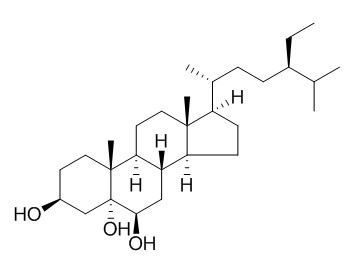Stigmastane-3,5,6-triol and derivatives could be used for preparing antiviral medicine.
Providing storage is as stated on the product vial and the vial is kept tightly sealed, the product can be stored for up to
24 months(2-8C).
Wherever possible, you should prepare and use solutions on the same day. However, if you need to make up stock solutions in advance, we recommend that you store the solution as aliquots in tightly sealed vials at -20C. Generally, these will be useable for up to two weeks. Before use, and prior to opening the vial we recommend that you allow your product to equilibrate to room temperature for at least 1 hour.
Need more advice on solubility, usage and handling? Please email to: service@chemfaces.com
The packaging of the product may have turned upside down during transportation, resulting in the natural compounds adhering to the neck or cap of the vial. take the vial out of its packaging and gently shake to let the compounds fall to the bottom of the vial. for liquid products, centrifuge at 200-500 RPM to gather the liquid at the bottom of the vial. try to avoid loss or contamination during handling.
Planta Medica, 2003, 69(7):667-672.
A Cytotoxic Butenolide, Two New Dolabellane Diterpenoids, a Chroman and a Benzoquinol Derivative Formosan Casearia membranacea.[Reference:
WebLink]
METHODS AND RESULTS:
Investigation of a cytotoxic chloroform-soluble fraction of the stem of Casearia membranacea (Flacourtiaceae) led to the isolation of five new compounds, including one butenolide, casealactone (1), one chroman, caseamemin (2), two dolabellane diterpenoids, casearimene A (3) and casearimene B (4), one benzoquinol ether, casearinone (5), together with fifteen known compounds, including two amides, N- trans-feruloyltyramine (6) and N- cis-feruloyltyramine (7), six steroids, beta-sitosterol (8), stigmast-5-ene-3beta,7alpha-diol (9), stigmast-5-ene-3beta,7beta-diol (10), stigmastane-3beta,5alpha,6beta-triol (Stigmastane-3,5,6-triol,11), beta-sitostenone (12), beta-sitosterol 3- O-beta-glucoside (13), two triterpenoids, squalene (14) and friedelin (15), one lignan, (+/-)-syringaresinol (16), two benzenoids, syringaldehyde (17) and vanillic acid (18), one ester, methyl hexadecanoate (19), and anthraquinone (20), respectively.
CONCLUSIONS:
Among these isolates, 1 showed cytotoxicity against P-388 and HT-29 cancer cell lines in vitro, and 6 and 7 showed cytotoxicity against the P-388 cancer cell line. The structures of these compounds were determined by means of spectroscopic techniques, and the structure of 3 was confirmed by X-ray crystallographic analysis.



